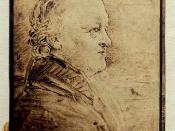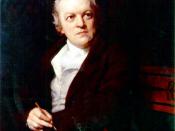William Blake was a truly gifted artist and visionary in every sense. Not only was he a brilliant poet who addressed important social and political views during his time, Blake's writings hold value during our own times as well. In addition to his talents as a writer, Blake was an accomplished painter as well. He is well known for his illustrations of of the works of Dante, Milton, and the Bible, not to mention his own poetry. It is this talent for painting that allows Blake to structure his prose in ways that other poets could not accomplish. By this I mean that other poets must completely rely on their words to convey the ideas of the poem to the reader whereas Blake is able to use imagery to contradict and juxtapose his poetry. This enables him to create certain imagery within the poem itself, and then contrast these images with paintings that show another view point, or maybe reveal a sense of sarcasm or irony that could not be attained without combining the two art forms.
This combination leaves a powerful message upon the reader, and gives great depth and insight to the works. In this essay I will be examining some of the songs from Songs of Innocence and Experience and looking at the meanings and relationships that the paintings have with the poems that they accompany.
In the song "The garden of Love", Blake uses the image of love to represent the "joys and desires" that occur naturally within him and within all people. In the first stanza:
I went to the Garden of Love,
And saw what I had never seen:
A Chapel was built in the midst,
Where I used to play on the green.
Blake creates a sense of child like innocence...


